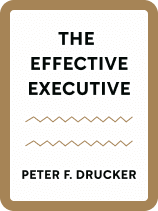

This article is an excerpt from the Shortform book guide to "The Effective Executive" by Peter F. Drucker. Shortform has the world's best summaries and analyses of books you should be reading.
Like this article? Sign up for a free trial here .
What is the difference between efficiency and effectiveness? Which attribute do you think is more important when it comes to organizational performance?
When it comes to results, Drucker differentiates between efficiency and effectiveness. Efficiency is getting a lot of things done, while effectiveness is choosing and getting the right things done.
Keep reading to learn about Peter Drucker’s efficiency and effectiveness dichotomy.
Peter Drucker on Efficiency vs Effectiveness
Further, Drucker writes that effectiveness, unlike innate attributes such as talent and intelligence, entails a set of practices you can learn. In fact, it’s essential to learn effectiveness because without it, talent and intelligence won’t get you anywhere. You need effectiveness to magnify and translate them into results.
Individual effectiveness is necessary for organizational effectiveness as well. Drucker argues that rather than hiring for talent, charisma, or a broad set of skills, organizations would be better off if they prioritized effectiveness: Hiring for and developing individual effectiveness strengthens organizations by increasing their performance and results. In turn, successful organizations—businesses, nonprofits, government, and educational institutions—strengthen the social order and provide services and products valuable to society.
| Hiring for Charisma Doesn’t Work Companies and their boards are often prone to hiring charismatic, high-profile, attention-getting CEOs. But Drucker wrote in 2005 that in 65 years of interviewing executives, he found no common qualities for success (neither charisma nor anything else). Top-performing executives varied in personality and style. Rather, what they had in common were key practices for effectiveness. Similarly, Jim Collins writes in Good to Great that charisma is overrated in hiring CEOs; some of the best CEOs he found were unassuming but disciplined and resolute. In Quiet, Susan Cain quotes a study of 128 executives showing that extroverted or charismatic leaders were no more effective than introverts. In some instances, introverted leaders performed better. Further, psychologist Carol Dweck writes in Mindset that hiring for charisma alone can lead to disaster, with the fall of Enron due to the arrogance of its leaders (who ignored the company’s issues) as a case in point. |
| Defining Personal Effectiveness Today In the years since Drucker defined effectiveness, much more has been written about what it is and how to achieve it. Many self-help authors on individual effectiveness define effectiveness either in terms of productivity (Drucker’s efficiency), or as a collection of personal qualities and leadership ability. For example, Getting Things Done focuses on effectiveness as productivity, but Stephen Covey’s The 7 Habits of Highly Effective People focuses more broadly on qualities and behaviors such as developing initiative, collaborating, and communicating. In The 21 Immutable Laws of Leadership, John Maxwell argues that effectiveness is contingent on leadership ability, then explains the behaviors, attitudes, and skills necessary for leadership—for example, planning, prioritizing, and persistence. In the trade-off between efficiency and effectiveness, Peter Drucker emphasizes the importance of focusing on the latter. His practical definition of effectiveness focuses on doing rather than being or becoming a certain type of leader. Defining Organizational Effectiveness Today Most current definitions of organizational effectiveness incorporate or morph into efficiency—for example, a typical definition of effectiveness is how efficiently an organization meets the outcomes and objectives it has defined for itself. However, efficiency is unsustainable—once you’ve maximized your process, there’s nowhere else to go; further, as your competitors improve, your process is no longer a differentiator. In contrast, Drucker’s definition of effectiveness—focusing on what an organization can do better rather than faster or cheaper—lends itself to innovation and ongoing growth. |
Drucker’s Five Practices for Effectiveness
This section presents an overview of Drucker’s five practices for effectiveness and how they’re viewed today.
The practices are interconnected, and they revolve around strategic thinking and prioritizing—that is, determining the highest-impact things you can do and making sure you get them done. Practices 1, 2, and 5—managing your time, doing key tasks, and making good decisions—all involve prioritizing; maximizing strengths (practice 4) requires knowing your unique contribution (practice 3) because it likely will relate to a strength. Here’s a brief look at each practice, then and now.
1) Manage your time: Know exactly how you’re using your time. Work diligently to manage the limited amount of your time you can control.
- (Shortform note: We’ve seen an explosion of time management books, methods, courses, and tools such as planners and apps, to the point where some think we’re overscheduled while others advocate scheduling even our leisure time. We’ve also layered in the concept of achieving work-life balance.)
2) Focus: Concentrate on a few high-impact tasks—areas where you can produce excellent results—one at a time. Set priorities and stick with them, ignoring distractions.
- (Shortform note: While time management practices initially addressed getting more done, which led to multitasking, that’s fallen out of favor. Science has shown that we can’t effectively do multiple things at once. Prioritizing is now the focus. Books such as 7 Habits, Eat That Frog, The One Thing, and many others address Drucker’s idea of doing less but doing the right things.)
3) Make your unique contribution: Focus on what you personally can do to significantly impact company performance and results. Ask yourself what results you need to produce rather than what tasks you need to do.
- (Shortform note: Results-based management began with Drucker’s introduction of MBOs—Management By Objectives—in the 1950s and is an ongoing trend in management and leadership. OKRs (Objectives and Key Results) and KPIs (Key Performance Indicators) are later evolutions of MBOs. Further, Drucker’s idea of focusing on your unique contribution to produce results is closely related to the next practice, which ties to yet another management trend noted below.)
4) Maximize strengths: Build on your strengths and those of the people around you, including your boss, to enhance their contributions and thus, the organization’s performance.
- (Shortform note: Strengths-based development of leaders and employees has become a mantra in human resources due to concerns about employee morale and research showing that playing to people’s strengths increases performance and profit.)
5) Make sound decisions: Focus on making only a few key decisions following a systematic process. Don’t strive for consensus but make a judgment after exploring a full spectrum of opinions, especially dissenting opinions.
- (Shortform note: While organizations and teams typically shy away from disagreement or conflict, the idea of constructive dissent as an obligation for leaders and employees is gaining currency as an antidote to groupthink.)
In The Effective Executive and subsequent writing, Drucker stressed that becoming effective is a modest, achievable goal for individuals and organizations. By building on strengths in particular, average people and organizations can achieve above-average performance. Everyone should be able to become effective by working at it. (Shortform note: The subsequent tools and training programs built on Drucker’s ideas underscore his point that effectiveness is learnable.)
In upcoming sections, we’ll explore in detail each of the five effectiveness practices, how they connect, and how others have interpreted the ideas.
| How Drucker Refined His Five Practices In the decades following The Effective Executive, Drucker wrote multiple articles on effectiveness, continuing to restate and refine the practices. His core ideas remained the same over many decades, but he divided his ideas into two approaches to effectiveness—individual and organizational. (Note that these approaches continued to overlap.) In a 2004 article, Drucker outlined these practices for organizational effectiveness:Ask what needs to be done and what’s right for the organization: The answers require setting priorities, sticking with them, and putting everything else on the back burner; determining and doing what you’re best at and delegating what you’re poor at doing.Develop action plans: This requires thinking about what results you want, possible constraints, check-in points and revisions, and how you’ll spend your time. Take responsibility for decisions and implementation: Determine who’s accountable, the deadlines, and who’s affected or needs to be informed; communicate and then hold people accountable for performance.Focus on exploiting opportunities rather than fixing problems.Make your meetings efficient and productive. Use ”we” rather than “I”; listen before speaking. In a second article, Drucker outlined practices for personal development and managing your career:Determine your strengths and focus on improving them.Determine how you work best, and then work that way.Identify your values.Determine where you belong (where your strengths will produce results).Ask what your contribution should be.Take responsibility for relationships (know and play to the strengths and preferences of your boss and coworkers).Take responsibility for communicating what you’re doing, how, and why. |

———End of Preview———
Like what you just read? Read the rest of the world's best book summary and analysis of Peter F. Drucker's "The Effective Executive" at Shortform .
Here's what you'll find in our full The Effective Executive summary :
- How to manage yourself before you can manage others
- The five practices that anyone can learn to be more effective
- Why leaders should purposely create disagreements






